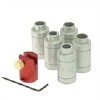Agree with Shooter.
Can't really imagine how a primer can fall out before you open the bolt, in a bolt gun. Or even back out eneough to fall out as the bolt is opened. Have you compared the shoulder datum to base dimension of once fire brass to your FL sized cases?
When you pull the trigger, the the firing pin drives the case forward until the shoulder of the case hits the shoulder of the chamber. Pressure starts to rise, and the thinnest part of the case, the mouth and neck, expands and sticks to the chamber. The primer can back out at this point. Then the case stretches until the base hits the bolt, driving the primer back into the primer pocket. If the length of the case from shoulder to base is too short, this is thought to cause case head separation.
What I'm getting at is if you have a longer chamber, and a shorter case from base to shoulder, that might be a problem to consider.
Also wonder what kind of scales and how you calibrate them.
Hope you sort it soon.




